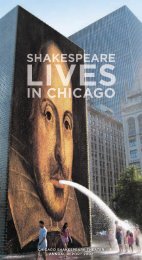Julius Caesar • 2013 - Chicago Shakespeare Theater
Julius Caesar • 2013 - Chicago Shakespeare Theater
Julius Caesar • 2013 - Chicago Shakespeare Theater
You also want an ePaper? Increase the reach of your titles
YUMPU automatically turns print PDFs into web optimized ePapers that Google loves.
82<br />
CLASSROOM ACTIVITIES<br />
✪ Costumes: In small groups, design costumes for <strong>Julius</strong> <strong>Caesar</strong>—you need not be artists! Take several pieces<br />
of cardboard or poster-board, swatches of fabric, pencils, markers, and paper with which to sketch out<br />
your ideas. The sketches can be very rough, and you can stick the fabrics to the poster-board with staples,<br />
pins, or glue. Aim to create one costume for every character in the play. As a class, build a “production<br />
costume board.” To the teacher: To build on this exercise, students can bring in articles of clothing and/or<br />
accessories or explore a thrift store for costume pieces that could be hung on the walls or used for group<br />
presentations during the study of the play.<br />
✪ Setting: Many directors take a traditional approach aiming to set <strong>Shakespeare</strong>’s plays as they imagine it to be<br />
played in Elizabethan England. In the world of theater, there are no rules about how to present a <strong>Shakespeare</strong>an<br />
play. What time period will you choose? What is Rome like? What do you want your audience to see when<br />
they first enter the theater? What colors will you use? What mood do you want to create? Is there a particular<br />
landscape you want to represent?<br />
✪ Sound and Music: Would you like to incorporate any sound and/or music into your version of <strong>Julius</strong> <strong>Caesar</strong>?<br />
Brainstorm adjectives, mood ideas and songs that come to mind. Make a list of songs and/or music that you<br />
think might fit your ideas for the play.<br />
Present your ideas to the class—all ideas are welcome when designing a play! As a class, discuss the implications<br />
of the decisions made by the groups. What impact would certain designs have on specific audiences? How<br />
would audiences respond to specific characters based simply on how they look? How could a single costume, a<br />
style of design or a piece of music affect the interpretation and presentation of the play as a whole? Once you’ve<br />
thought through your own ideas about the production’s design elements, you’ll have the chance to compare them<br />
with those that director Jonathan Munby and his design team have made. In your mind, which worked particularly<br />
well, and why? Which in your mind were less successful—and why? CONSIDER COMMON CORE ANCHOR STAN-<br />
DARDS RL1, RL2, SL1, SL2, SL4, SL5<br />
Extra! Extra!<br />
Often, a director will choose to “theatricalize” the play’s opening moments, portraying a scene (usually without<br />
text) that helps draw the audience into the play. Scholars call these “extratextual” scenes—in other words, they<br />
appear outside the text. If you were directing <strong>Julius</strong> <strong>Caesar</strong> and wanted to theatricalize a brief scene just prior to<br />
the first words spoken of the text by the Flavius, what would your “extratextual” scene look like? Watch how the<br />
director chooses to theatricalize the opening of this production. What information does he seem to want to be<br />
communicating to the audience before the opening lines of <strong>Shakespeare</strong>’s script? CONSIDER COMMON CORE<br />
ANCHOR STANDARDS R5, W2, W9<br />
www chicagoshakespeare com 75




